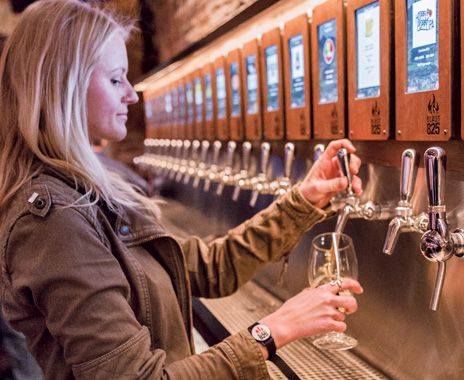While a growing number of fast casuals are employing touchscreen kiosks, some are taking self-service beyond the order station. From self-serve frozen yogurt to cupcake dispensing machines to pour-your-own beer walls, these help-yourself systems are giving customers the power to choose their own portions while having fun with the experience.
For many brands, the most logical menu items to go self-serve are soft drinks. From the standard carbonated beverage dispenser to the Coke Freestyle, which offers a creative interface for customizing Coca-Cola products, beverages have become more fun for guests to mix and pour while eliminating a tedious chore previously handled by employees.
Expanding the beverage self-service to beer and wine can add fun for guests while at the same time increasing alcohol sales in the fast-casual segment, says Darren Nicholson, vice president of sales and marketing for iPourIt, a provider of self-service beverage systems.
Nicholson says that as more fast-casual concepts serve beer and wine, there are challenges to overcome. Technology that allows guests to be their own bartenders can be the solution to some of these challenges. For example, when beer and wine are offered in bottles and cans, it discourages alcohol sales beyond one drink because customers don’t want to get back in line. In addition, workers in the fast-casual segment are sometimes too young to handle alcohol.
With most self-service alcohol tools, after servers check a customer’s ID, they open a tab tied to a credit card. Users preload a certain amount to get started but can add to their tab later. Customers then receive a card or other tool that allows them to measure what they pour. They can try as many beers as they like, and they only pay for what they pour.
iPourIt reports on its website that once its system is installed in a restaurant, it’s not uncommon to see alcohol revenues increase 39 percent or more, and iPourIt clients have also experienced the self-serve taps leading to even greater food revenues. The system also captures data about customers and their purchase habits, which operators can link with loyalty programs or use for marketing and promotional purposes.
“Customers do all the hard work of pouring their own beer, and they love it and thank you for it,” Nicholson says.
Safety concerns prevent some aspects of fast-casual service from becoming DIY, however. Operators wouldn’t want customers reaching into an 800-degree pizza oven or cutting vegetables with sharp chef knives.
Orange Leaf Frozen Yogurt, for example, has had success with self-serve frozen yogurt but has changed course with other menu options. The brand introduced smoothies in 2014 and, more recently, Swizzle blended fro-yo and topping creations, with the intention of making those items self-serve. In the end, Orange Leaf decided it would be best for team members, not guests, to blend these items.
“We considered having these items be self-serve, but the challenge was, what is the mechanism that allows them to blend safely on their own?” says Geoff Goodman, president of Orange Leaf.
Goodman says Orange Leaf hasn’t removed the element of creation from the blended products, as guests are still in charge of exactly what ingredients go into them. By handing it over to a team member for blending, Orange Leaf ensures guest safety and consistent product execution every time.
The self-service fro-yo is becoming even simpler for guests to dispense and purchase as Orange Leaf is transitioning from selling it by the ounce to pricing it by the cup.
There’s no scale or blender involved in the Sprinkles Cupcakes ATM, a self-service technology rolled out four years ago.
Nicole Schwartz, Sprinkles Cupcakes vice president of marketing, says Cupcake ATMs have been installed at 12 of the concept’s 20 locations, and there are plans to have ATMs not only at all bakery locations soon, but to also operate some standalone cupcake ATMs in high-foot-traffic areas at airports and college campuses.
Schwartz says the advantage of the Cupcake ATMs for customers is they make cupcakes available 24/7.
“In this hustle-and-bustle world we live in, our customers have come to rely on being able to get a freshly baked cupcake during off-hours, like during their morning commute at 6 a.m. or after a fun night partying at 2 a.m.,” she says.
Another advantage of self-service, Schwartz says, is the fun factor.
“People enjoy using the ATMs so much, they frequently post pictures of themselves using them on social media,” she says. “We do a lot of fun promotions with our Cupcake ATMs, which get our stores very excited, too. For example, we’ll hide gift cards, concert tickets, and other prizes."
A big question regarding self-service tools for restaurants is whether adopting the technology ultimately saves on labor costs. Schwartz says that in the case of Sprinkles, it does not, primarily because cupcake ATMs increase volume, so whatever labor is saved in serving customers is needed to bake and supply enough cupcakes for the ATMs. Plus, Sprinkles incurs the costs of stocking the ATM, monitoring sales, and servicing the machine.
As with most operational undertakings, the key to successfully adopting self-service technology lies in a balanced approach.
“Customers who want to get a cupcake and run can now opt for the Cupcake ATM,” Schwartz says. “This leaves us more time to give attention to customers who have highly customized orders or desire a more interactive experience.”





